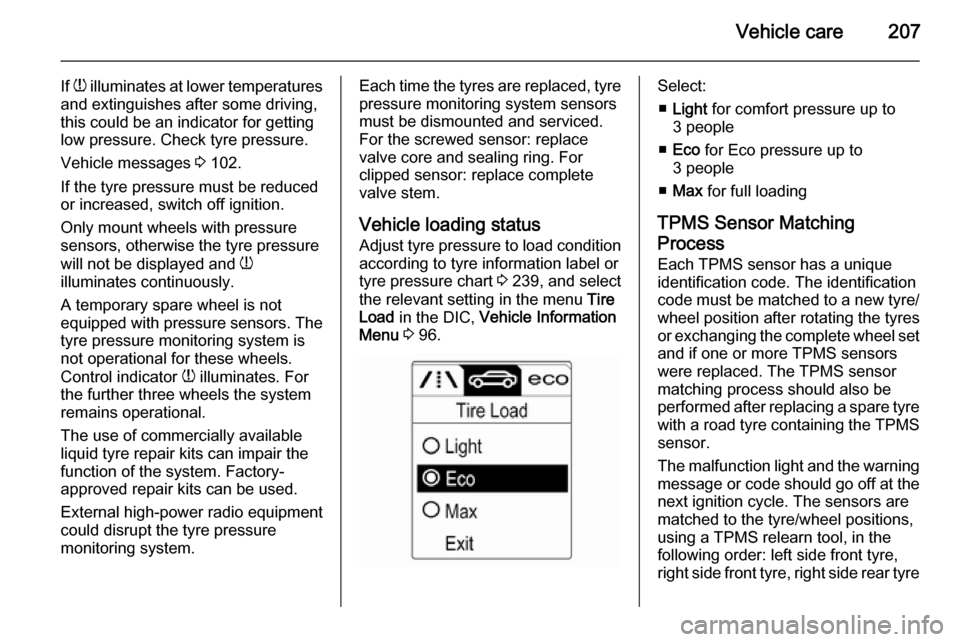ignition OPEL CASCADA 2015 Manual user
[x] Cancel search | Manufacturer: OPEL, Model Year: 2015, Model line: CASCADA, Model: OPEL CASCADA 2015Pages: 253, PDF Size: 7.58 MB
Page 209 of 253

Vehicle care207
If w illuminates at lower temperatures
and extinguishes after some driving,
this could be an indicator for getting
low pressure. Check tyre pressure.
Vehicle messages 3 102.
If the tyre pressure must be reduced
or increased, switch off ignition.
Only mount wheels with pressure
sensors, otherwise the tyre pressure
will not be displayed and w
illuminates continuously.
A temporary spare wheel is not
equipped with pressure sensors. The
tyre pressure monitoring system is
not operational for these wheels.
Control indicator w illuminates. For
the further three wheels the system
remains operational.
The use of commercially available
liquid tyre repair kits can impair the
function of the system. Factory-
approved repair kits can be used.
External high-power radio equipment
could disrupt the tyre pressure
monitoring system.Each time the tyres are replaced, tyre pressure monitoring system sensors
must be dismounted and serviced.
For the screwed sensor: replace
valve core and sealing ring. For
clipped sensor: replace complete
valve stem.
Vehicle loading status Adjust tyre pressure to load condition according to tyre information label or
tyre pressure chart 3 239, and select
the relevant setting in the menu Tire
Load in the DIC, Vehicle Information
Menu 3 96.Select:
■ Light for comfort pressure up to
3 people
■ Eco for Eco pressure up to
3 people
■ Max for full loading
TPMS Sensor Matching
Process
Each TPMS sensor has a unique
identification code. The identification
code must be matched to a new tyre/
wheel position after rotating the tyres
or exchanging the complete wheel set and if one or more TPMS sensors
were replaced. The TPMS sensor matching process should also be
performed after replacing a spare tyre
with a road tyre containing the TPMS
sensor.
The malfunction light and the warning
message or code should go off at the
next ignition cycle. The sensors are
matched to the tyre/wheel positions,
using a TPMS relearn tool, in the
following order: left side front tyre,
right side front tyre, right side rear tyre
Page 210 of 253

208Vehicle care
and left side rear tyre. The turn signal
light at the current active position is
illuminated until sensor is matched.
Consult your workshop for service or
to purchase a relearn tool. There are two minutes to match the first tyre/wheel position, and five minutes
overall to match all four tyre/wheel
positions. If it takes longer, the
matching process stops and must be
restarted.
The TPMS sensor matching process is:
1. Apply the parking brake; on vehicles with automatic
transmission set the selector lever
to P.
2. Turn the ignition on.
3. Use the MENU button on the turn
signal lever to select the Vehicle
Information Menu in the Driver
Information Centre (DIC).
4. Turn the adjuster wheel to scroll to
the tyre pressure menu.5. Press the SET/CLR button to
begin the sensor matching process. A message requesting
acceptance of the process should display.
6. Press the SET/CLR button again
to confirm the selection. The horn
sounds twice to signal the
receiver is in relearn mode.
7. Start with the left side front tyre.
8. Place the relearn tool against the tyre sidewall, near the valve stem.Then press the button to activate
the TPMS sensor. A horn chirp
confirms that the sensor
identification code has been
matched to this tyre and wheel
position.
9. Proceed to the right side front tyre,
and repeat the procedure in
Step 8.
10. Proceed to the right side rear tyre,
and repeat the procedure in
Step 8.
11. Proceed to the left side rear tyre, and repeat the procedure in
Step 8. The horn sounds twice toindicate the sensor identification
code has been matched to the left side rear tyre, and the TPMS
sensor matching process is no
longer active.
12. Turn off the ignition.
13. Set all four tyres to the recommended air pressure level
as indicated on the tyre pressure label.
14. Ensure the tyre loading status is set according selected pressure
3 96.
Temperature dependency
Tyre pressure depends on the
temperature of the tyre. During
driving, tyre temperature and
pressure increase.
The tyre pressure value displayed in
the DIC shows the actual tyre
pressure. Therefore it is important to
check tyre pressure with cold tyres.
Tread depth
Check tread depth at regular
intervals.
Page 223 of 253

Vehicle care221
Screw in the towing eye anticlockwise
as far as it will go until it stops in a
horizontal position.
Attach a tow rope – or better still a tow
rod – to the towing eye.
The towing eye must only be used for
towing and not for recovering the
vehicle.
Switch on ignition to release steering
wheel lock and to permit operation of
brake lights, horn and windscreen
wiper.
Transmission in neutral.
Caution
Drive slowly. Do not drive jerkily.
Excessive tractive force can
damage the vehicle.
When the engine is not running,
considerably more force is needed to
brake and steer.
To prevent the entry of exhaust gases from the towing vehicle, switch on the
air recirculation and close the
windows, when soft top is closed.
Vehicles with automatic transmission: The vehicle must be towed facing
forwards, not faster than 80 km/h nor further than 100 km. In all other cases
and when the transmission is
defective, the front axle must be
raised off the ground.
Seek the assistance of a workshop.
After towing, unscrew the towing eye
clockwise.
Insert cap at the top and engage
downwards.
Towing another vehicle
Insert a screwdriver in the slot at the
lower bend of the cap. Release the
cap by carefully moving the
screwdriver downwards.
The towing eye is stowed with the
vehicle tools 3 203.
Page 246 of 253

244Customer information
of the vehicle. This enables the
workshop to offer you efficient
maintenance and repair, tailored to
your individual vehicle, each time you bring it back to the workshop.
The manufacturer will not access
driver's behaviour related information
about a crash event or share it with
others except:
■ with the consent of the vehicle owner or, if the vehicle is leased, of
the lessee
■ in response to an official request of
police or similar government office
■ as part of the manufacturer's defense in case of legal
proceedings
■ as required by lawIn addition, the manufacturer may use the collected or received diagnostic
data:
■ for the manufacturer's research needs
■ to make it available for research needs where appropriate
confidentiality is maintained and
need is shown
■ to share summary data which is not
tied to a specific vehicle with otherorganisations for research
purposesRadio Frequency
Identification (RFID)
RFID technology is used in some
vehicles for functions such as tyre
pressure monitoring and ignition
system security. It is also used in
connection with conveniences such
as radio remote controls for door
locking/unlocking and starting, and in-
vehicle transmitters for garage door
openers. RFID technology in Opel
vehicles does not use or record
personal information or link with any
other Opel system containing
personal information.
Page 250 of 253

248
Headlight range adjustment ......113
Headlights................................... 110
Headlights when driving abroad 113
Head restraint adjustment .............8
Head restraints ............................ 46
Heated mirrors ............................. 31
Heated rear window ..................... 34
Heated steering wheel .................79
Heating ........................................ 54
Heating and ventilation system . 123
High beam ........................... 95, 111
High beam assist ..................95, 112
Hill start assist ........................... 147
Horn ....................................... 14, 79
I
Identification plate .....................229
Ignition switch positions .............134
Immobiliser ............................ 29, 95
Indicators ...................................... 85
Information displays...................... 96
Instrument cluster ........................85
Instrument panel fuse box .........200
Instrument panel illumination .....197
Instrument panel illumination control .................................... 119
Instrument panel overview ........... 10
Interactive driving system ...........149
Interior care ............................... 224
Interior lighting ............................ 119Interior lights ...................... 119, 197
Interior mirrors .............................. 31
Interruption of power supply ......143
Introduction .................................... 3
ISOFIX child restraint systems ....69
J
Jump starting ............................. 219
K
Key, memorised settings ..............22
Keys ............................................. 20
Keys, locks ................................... 20
L
Lane departure warning .......93, 171
Lashing eyes ............................... 76
Light switch ................................ 110
Load compartment ................25, 73
Load compartment fuse box ......201
Loading information .....................77
Low fuel ....................................... 94
M
Malfunction indicator light ............91
Manual anti-dazzle ......................31
Manual mode ............................. 142
Manual transmission .................. 144
Memorised settings ......................22Mirror adjustment ........................... 9
Misted light covers .....................119
N New vehicle running-in ..............134
Number plate light .....................196
O Object detection systems ...........157
Odometer ..................................... 86
Oil, engine .......................... 227, 231
Operate pedal ............................... 91
Outside temperature ....................82
Overrun cut-off ........................... 136
P Parking ................................ 18, 138
Parking assist ............................ 157
Parking brake ............................ 145
Parking lights ............................. 118
Particulate filter ........................... 139
Performance .............................. 235
Performing work ........................182
Pollen filter ................................. 132
Power outlets ............................... 84
Power seat adjustment ................52
Power steering.............................. 93
Power steering fluid ....................185
Power windows ............................ 32